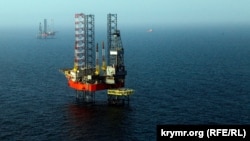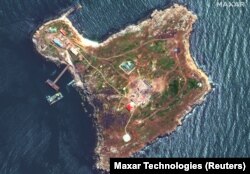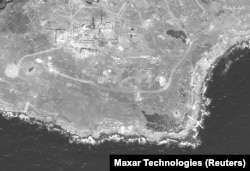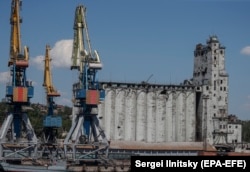Ukraine’s strike earlier this month against a natural-gas platform in the Black Sea may be part of a wider campaign by Kyiv to weaken Russian capabilities in the strategic waters and free up shipping lanes for grain exports.
Ukraine on June 20 struck one of several offshore structures used by Russia to produce and deliver natural gas to Kremlin-controlled Crimea, where it is largely used for heating purposes in the winter.
The strike caused a major fire that online sleuths say is still burning.
Three people were injured, while seven are missing, Crimean officials said.
However, Ukraine’s ultimate goal may have been to destroy Russian intelligence equipment believed to be installed on platforms and rigs in the waters, rather than the interruption of gas flows, analysts said.
The attack was at least the third against Russian targets in the Black Sea within the span of a few days and may reflect the deployment in Ukraine of recently arrived, high-tech Western missile systems.
The United States and NATO allies have sent Ukraine advanced Harpoon anti-ship missiles systems, though it is unclear what weapon struck the platform.
WATCH: Satellite images bolster accusations that Russia is transporting huge quantities of stolen Ukrainian grain to Bashar al-Assad's regime in Syria. RFE/RL's Ukrainian Service has documented a series of shipments through the largest grain terminal in Russian-occupied Crimea.
The West is seeking to help Ukraine ensure the safe export of millions of tons of grain trapped in its Black Sea ports due to what they say is a Russian military blockade. The Kremlin denies the accusation.
Ukraine is one of the world’s largest exporters of wheat, and the blockade has caused grain prices to spike and driven fears of a global food shortage.
The grain exports are also a key source of revenue for Ukraine, whose economy has been destroyed by Russia’s invasion. The grain is at risk of rotting if not shipped soon, experts say.
The attack on the offshore platform came amid two strikes in the vicinity of Snake Island, a small but strategic outpost in the Black Sea captured by Russia in the early days of its invasion.
Russia has been supplying anti-ship and antiaircraft missiles as well as radar systems to its forces on Snake Island, located about 40 kilometers from Ukraine’s coast.
Control of Snake Island enables Russia to threaten the sea lanes leading to and from Odesa, Ukraine’s main port for shipping grain to the world.
Ukraine’s military on June 17 claimed it sunk a Russian supply tug it said was delivering ammunition, weapons, and personnel to Snake Island.
Four days later, it announced strikes against Russian targets on the island, including an antiaircraft defense system, a radar system, and other equipment. Russia claimed it shot down the missiles fired by Ukraine.
Satellite images of Snake Island before and after June 21 show three scorched areas, indications of possible missile strikes, but it was unclear what, aside from a tower, was damaged.
The gas platform attack “must be seen in light of strikes on Snake Island to prevent the Russians from turning it into an [area denial] zone,” said Glen Howard, a military expert and president of the Washington-based Jamestown Foundation.
“If the grain ships can get out of Odesa…then these efforts could be part of a campaign to clear the sea lanes to enable the Ukrainian ships to leave Odesa and hug the coast," he said.
Radars, Jamming Devices
Russia seized Ukraine’s Black Sea offshore gas fields and equipment in 2014, following its forcible annexation of Crimea, and placed at least three radar systems on its platforms and rigs, according to a report by Ukrainian military and energy experts.
An investigation by RFE/RL showed that in 2019 Chyornomorneftegaz, the Russian state-owned company producing gas in the Black Sea, ordered spare components for the same radar systems identified in the report.
Depending on where the mobile drilling rigs are located, they can monitor almost the entire northern waters of the Black Sea, including the movements of ships entering or leaving Ukrainian ports.
The platform struck by the missile was located about 70 kilometers from Odesa, according to Crimean news outlets.
The radar systems believed to be installed on the rigs and platforms would provide real-time information to Russia’s Black Sea Fleet in Crimea, as well as the border division of Russia's Federal Security Service (FSB).
The report by the Ukrainian experts did not identify the platform damaged on June 20 as one of the structures installed with a radar system. However, Mikhailo Honchar, one of the authors of the report, told RFE/RL that Russia has been installing more equipment on the offshore gas structures after the April sinking of the Moskva, the flagship of Russia’s Black Sea fleet.
The Moskva served as the command-and-control ship for Russia’s Black Sea Fleet and was equipped with critical communications infrastructure.
Russia has sought to make Snake Island the stationary location for radar systems, but the attacks by Ukraine have made that difficult, so additional intelligence-gathering equipment has been added to the platforms, Honchar said.
Unlike rigs, which are mobile, platforms are permanent structures.
Honchar said he did not think gas production was the priority of the strike. The missile damaged the platform but may not have damaged the underwater infrastructure, where gas is pumped into pipelines.
Even if the integrity of the undersea infrastructure is impacted and needs to be repaired, Russia can ship gas to Crimea via a pipeline from its southern region of Krasnodar, Honchar said.
Andriy Ryzhenko, a former Ukrainian Navy captain, said the platforms and rigs also contain Russian electronic-jamming devices aimed at impairing Ukrainian defenses.
He agreed the main reason for attacking the platform was to blunt Russian intelligence capabilities.

















